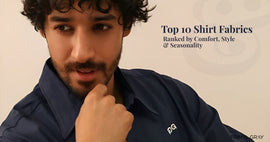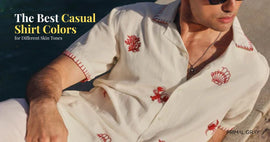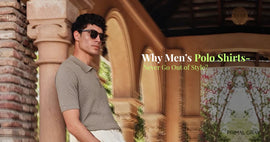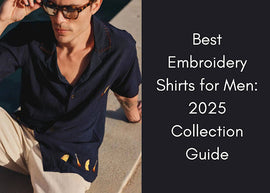Embroidered Shirts vs. Printed Shirts: Which Is Best?
Posted by Primal Gray
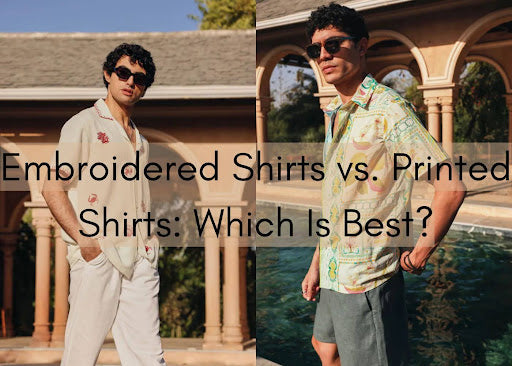
Picture this: Leonardo DiCaprio stepping out in "The Great Gatsby" wearing that impeccable embroidered dress shirt, or think about how Harry Styles rocks printed statement pieces that stop traffic at every red carpet event. The debate between embroidered shirts vs printed shirts isn't just about fashion preferences, it's about understanding which statement shirts align with your lifestyle, budget, and personal brand.
Trendy shirts for men in 2025 encompass both categories, but choosing between intricate needlework and vibrant prints can feel like picking between a vintage Rolex and a limited-edition sneaker drop. Both serve different purposes, occasions, and style philosophies that define modern men's fashion.
Understanding the Fundamental Differences
Embroidered and printed shirts represent two distinct manufacturing philosophies that create completely different aesthetic and functional outcomes. Embroidered shirt men's pieces feature threads sewn directly into the base fabric, creating raised, textural designs that add dimension and tactile appeal. Printed shirts use various printing techniques to apply designs onto fabric surfaces, resulting in flat, graphic elements that can showcase complex artwork and vibrant color combinations.
Construction and Manufacturing Processes
Embroidery production involves precise needle placement that punctures fabric thousands of times to create intricate patterns using specialized threads. This process requires significant time investment, with complex designs taking hours to complete on industrial machines. Quality embroidered pieces like the sophisticated Navy Tequila Embroidered Oversized Shirt use stabilizing materials behind the fabric to prevent puckering and ensure long-term structural integrity.
Embroidery Manufacturing Stages
Professional embroidery follows systematic steps that determine final quality and durability:
- Design digitization converts artwork into machine-readable stitch patterns
- Fabric stabilization applies backing materials to prevent distortion
- Thread selection chooses appropriate materials for design requirements
- Machine setup calibrates tension, speed, and needle specifications
- Quality monitoring ensures consistent stitch density throughout production
- Finishing processes remove excess stabilizer and trim loose threads
Printing processes vary significantly depending on technique, substrate, and desired outcome. Screen printing builds layers of ink through mesh stencils, while digital printing applies designs directly using specialized inkjet technology. Heat transfer methods apply pre-printed designs using temperature and pressure, creating different textures and durability characteristics found in pieces like the vibrant Blue Big Lemon Printed Mul Satin Shirt.
Durability and Longevity Comparison
Embroidered designs typically outlast printed graphics due to their structural integration with base fabrics. High-quality embroidery can withstand decades of regular wear and washing when properly maintained, with threads becoming softer and more comfortable over time rather than deteriorating. The Olive Champagne Embroidered Oversized Shirt exemplifies this durability with its premium rayon-flax blend construction.
|
Aspect |
Embroidered Shirts |
Printed Shirts |
|
Wash Resistance |
Excellent - threads integrated into fabric |
Good to Fair - depends on print method |
|
Color Retention |
Superior - thread dyes resist fading |
Variable - digital prints may fade faster |
|
Texture Longevity |
Improves with age - softens naturally |
Deteriorates - may crack or peel over time |
|
Repair Potential |
Difficult but possible with skilled tailoring |
Nearly impossible once damaged |
|
Care Requirements |
Professional cleaning recommended |
Machine washable with proper settings |
Printed shirt durability depends heavily on manufacturing quality and the printing technique used. Premium printed pieces using high-grade inks and proper curing processes can maintain appearance for years, while budget options may show wear after minimal use. The Green Block Small Lemon Printed Mul Satin Shirt demonstrates how quality materials and printing methods create durable printed pieces.
Style Versatility and Occasion Appropriateness
Embroidered shirts traditionally lean formal, but modern interpretations span casual to black-tie events. Men's embroidered shirt pieces work exceptionally well for business casual environments, dinner dates, and vacation settings where understated sophistication matters more than bold visual impact. The White Beach Embroidered Oversized Casual Shirt perfectly illustrates this versatility with its elegant rayon-flax blend suitable for resort dining and sunset gatherings.
Printed shirts offer maximum creative expression through unlimited color combinations, complex graphics, and artistic collaborations. Statement shirts in printed form can showcase everything from abstract art to cultural references, making them perfect for creative industries, casual gatherings, and personal expression priorities.
Styling Scenarios Breakdown
Consider your wardrobe needs when choosing between embroidered and printed options:
Embroidered shirts excel in:
- Business casual environments requiring subtle sophistication
- Date nights where texture adds visual interest without distraction
- Vacation dining where relaxed luxury creates appropriate impressions
- Networking events needing conversation starters that remain professional
- Transitional seasons where layering showcases embroidery details
Printed shirts dominate in:
- Creative workplace cultures embracing personal expression
- Weekend activities where bold graphics match energetic atmospheres
- Music festivals and cultural events celebrating artistic statements
- Beach clubs and pool parties requiring eye-catching vacation vibes like the White Big Lemon Printed Mul Satin Shirt
- Social media-worthy moments demanding photogenic visual impact
Cost Analysis and Value Proposition
Embroidered shirts command premium pricing due to labor-intensive production processes and specialized equipment requirements. Quality embroidery work justifies higher costs through superior longevity and timeless appeal that transcends seasonal trends.
Printed shirts offer accessible entry points into statement fashion without significant financial commitment. Mass production capabilities allow brands to offer trendy designs at various price points, making fashion experimentation financially viable for broader audiences. The Coral Block Small Lemon Printed Mul Satin Shirt showcases how premium printed pieces can deliver both quality and artistic expression.
Investment Perspective
Calculate cost-per-wear ratios when making purchasing decisions. Premium embroidered pieces might cost more initially but provide years of versatile service, while printed options offer immediate gratification and trend participation at lower risk levels.
Smart wardrobe building incorporates both categories strategically. Foundation pieces benefit from embroidered sophistication, while trend-driven additions work well in printed formats that can be updated regularly without major financial impact.
Care and Maintenance Requirements
Embroidered shirts demand specialized attention to preserve thread integrity and prevent damage during cleaning processes. Professional dry cleaning represents the safest option for valuable embroidered pieces, particularly those featuring silk threads or complex multi-color designs like the intricate work found on premium men's embroidered shirts.
Printed shirts generally accept standard care routines with basic precautions to protect graphic elements. Machine washing at 30 degrees works well for most printed pieces, though inside-out washing and air drying help maintain color vibrancy and prevent cracking.
Understanding maintenance requirements helps inform purchase decisions:
Embroidered Shirt Care:
- Professional dry cleaning for silk embroidery pieces
- Hand washing acceptable for cotton thread designs
- Steam pressing around embroidered areas only
- Specialized storage to prevent thread snagging
- Immediate attention to loose threads or pulling
Printed Shirt Care:
- Machine washing at recommended temperatures
- Inside-out washing to protect printed surfaces
- Air drying preferred over high-heat machine drying
- Standard ironing with heat-appropriate settings
- Stain treatment using gentle, color-safe methods
Seasonal Considerations and Climate Adaptability
Embroidered shirts often feature heavier construction due to thread density and stabilizing materials, making them excellent choices for cooler months or air-conditioned environments. However, premium pieces like those crafted with breathable rayon-flax blends maintain comfort across seasons.
Printed shirts typically offer lighter-weight options perfect for summer heat and high-activity situations. The cotton mulmul and poly satin combinations found in quality printed pieces provide excellent moisture management while maintaining visual appeal during outdoor events and tropical vacations.
Check out Primal Gray’s collection of men’s shirts for premium embroidered and printed shirts.
Key Takeaways
- Embroidered shirts provide superior longevity and formal versatility but require higher initial investment and specialized care routines.
- Printed shirts offer maximum creative expression and accessible pricing while delivering immediate trend participation and easy maintenance.
- Both styles serve distinct wardrobe functions with embroidery handling sophisticated occasions and prints dominating casual, expressive settings.
- Quality matters more than technique, premium examples in either category outperform budget alternatives regardless of construction method.
- Smart wardrobe building incorporates both approaches strategically based on lifestyle needs, budget constraints, and personal style preferences.
- Future trends favor hybrid designs combining embroidered sophistication with printed creativity for maximum visual impact and versatility
Frequently Asked Questions
What's better, embroidered or printed shirts?
Neither is universally better, each serves different purposes and preferences. Embroidered shirts excel in formal and semi-formal settings, offering superior longevity and sophisticated texture that improves with age. Printed shirts dominate creative and casual environments, providing unlimited design possibilities and accessible pricing for trend experimentation. Your lifestyle, budget, and personal style determine which option better suits your wardrobe needs, with most well-rounded collections incorporating both approaches strategically.
Which style lasts longer?
Embroidered shirts typically outlast printed alternatives due to their structural integration with base fabrics. Quality embroidery becomes part of the fabric itself, with threads often softening and improving over time rather than deteriorating. Printed designs face surface-level wear from washing, sun exposure, and general use, potentially cracking or fading after extended wear. However, premium printing techniques using high-grade inks can maintain appearance for years when properly cared for, making quality more important than technique alone.
Are embroidered shirts more formal than printed ones?
Traditionally, yes, but modern interpretations blur these boundaries significantly. Classic embroidered shirts with subtle monograms or small logos lean formal and work well in business settings, while contemporary embroidered pieces can be quite casual depending on design complexity and placement. Printed shirts range from highly casual graphic tees to sophisticated artistic collaborations suitable for creative professional environments. Context and execution matter more than technique - a well-designed printed shirt can appear more refined than poorly executed embroidery.
How do I care for embroidered vs printed shirts differently?
Embroidered shirts require more specialized care to protect thread integrity and prevent damage during cleaning. Professional dry cleaning works best for silk embroidery, while cotton thread pieces accept gentle hand washing. Printed shirts generally accept standard machine washing at 30 degrees Celsius, though inside-out washing and air drying help maintain graphics longer. Both benefit from prompt stain treatment and appropriate storage, but embroidered pieces need extra attention to prevent thread snagging or pulling during handling.
Which option offers better value for money?
Value depends on your priorities and usage patterns. Embroidered shirts cost more initially but provide superior longevity and versatility across multiple occasions, potentially offering better cost-per-wear ratios over time. Printed shirts deliver immediate gratification and trend participation at accessible price points, making them ideal for experimental style choices or frequent wardrobe updates. Smart shoppers invest in quality examples of both categories rather than choosing exclusively, building versatile wardrobes that handle diverse style requirements effectively.
Can I wear embroidered and printed shirts together?
Layering embroidered and printed pieces requires careful consideration but can create sophisticated, textural looks when done thoughtfully. Subtle embroidered pieces work well over printed base layers, while busy embroidered designs should avoid competing printed elements. Color coordination and proportion balance become crucial - let one element dominate while the other provides supporting detail. Modern fashion encourages creative mixing of textures and techniques, making this combination increasingly acceptable in casual and creative environments where personal expression takes precedence over traditional rules.


